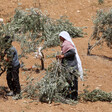Rights and Accountability 3 June 2024

Palestinians return to their homes following the Israeli army’s withdrawal from the Jabaliya area in the northern Gaza Strip, on 31 May.
APA imagesIsrael declared near total “operational control” in northern Gaza in late December 2023, around two months into its ground invasion of the coastal enclave.
Efforts to capture the north included an invasion of Jabaliya refugee camp. It was the first of two such invasions, with the second only ending in late May.
Last week, Israeli military forces withdrew from Jabaliya, a city in northern Gaza, after a 20-day operation that left the area and its refugee camp, the largest of the Gaza Strip’s eight camps, almost unrecognizable.
The Israeli army had ordered residents of Jabaliya to evacuate the area earlier in May.
Israel claimed that the evacuation was required so that it could confront fighters with the Qassam Brigades – the armed wing of Hamas. The fighters were allegedly attempting to reassemble in the area months after the initial invasion.
The latest ground invasion was combined with aerial bombardment. Israel conducted 200 airstrikes in the area during a period of less than three weeks.
“There is no longer Jabaliya camp, there are no schools and hospitals, the scale of destruction is so great that no one can imagine it, and the destruction cannot be counted,” Palestinian woman Asma al-Masri told Al Jazeera. She had returned to the camp to retrieve supplies for her family in Beit Hanoun, another northern area.
Northern Gaza was the first target of Israel’s ground invasion, and became the epicenter of an Israeli-US manufactured famine that forced people to rely on animal feed and wild plant foraging in order to eat.
The head of the World Food Program has declared a “full-blown famine” in northern Gaza.
Jabaliya refugee camp was already devastated by Israeli bombings since the early stages of Israel’s genocide in Gaza, when the Israeli airforce conducted multiple massive strikes on the camp’s market, considered one of the liveliest areas in the Strip, as well as a residential block, killing hundreds of people.
The devastation caused by the Israeli army’s second invasion of the area multiplied. As Palestinians began to return, witnesses described scenes of destruction: heaps of rubble from demolished buildings lined the streets, with decomposing bodies being discovered among the debris.Satellite imagery capturing the period between 17 April and 24 May depicts a stark increase in the destruction of residential buildings and vegetation in the area.
Anas al-Sharif, an Al Jazeera correspondent in Jabaliya, describes in a televised report Israel’s devastation of the central market in the refugee camp, detailing the burning and total destruction of commercial stores.
“This market was the lifeline of citizens,” he says, lamenting the absence of any remaining operational commercial outlets.
Resistance
Back in January, the Israeli military claimed, “We have completed the dismantling of Hamas’ military framework in the northern Gaza Strip.”
“Eliminating the commanders made it difficult for the terrorists to fight organized and led to many of them surrendering,” the military added.
But the manner in which Palestinian resistance fighters confronted the Israeli invaders does not suggest surrender.
Despite the devastation caused by the Israeli army, the Palestinian resistance inflicted losses among Israeli soldiers and military vehicles.The Qassam Brigades published videos showing its fighters employing a range of tactics to counter the encroachment of the Israeli military, by targeting its armored vehicles and soldiers with sniper operations, tunnel ambushes, mortar shells and attacks on armored vehicles. Yassin 105 anti-tank rockets – a Soviet clone manufactured in Gaza – were widely used by fighters against Israeli army vehicles.
When the invaders arrived in the camp, the Qassam Brigades launched an attack on Israeli troop carriers using ammunition delivered by an unmanned copter.
In a video released by the Qassam Brigades, an aircraft is seen positioning itself directly over an Israeli troop carrier, revealing a hatch on its front left side where the Qassam ammunition is deployed.
“Adnan al-Ghoul started the weapons program with hand grenades, because that was the simplest thing to get in the hand of every fighter,” Jon Elmer, contributing editor of The Electronic Intifada, said on the day 222 livestream. Al-Ghoul was the founder of the Qassam weapons industry and was assassinated in 2004.
“If you build your own hand grenades and give them to your fighters, it’s easier to have than guns at times, and so hand grenades were the first of Qassam’s weapons industry,” Elmer added.
The dense urban landscape of Jabaliya and its refugee camp is reflected in the operations carried out by Qassam fighters, as seen in videos published by their media team. These videos depict fighters maneuvering through alleys and buildings, positioning themselves to fire at tanks from close range.
Even as the Israeli army was on the ground in Jabaliya, the Palestinian resistance managed to launch rockets towards Israel.“These are launches from Jabaliya, where an entire Israeli army division is operating, and they’re firing rockets,” Elmer said.
“The tanks are all over there and they see the rockets go over their head. And it’s a psychological operation.”
One of the most striking reports by the Qassam Brigades from the battle in Jabaliya was the announcement by their spokesperson Abu Obeida of an operation that involved killing, injuring and capturing soldiers.
Abu Obeida said that Qassam fighters had lured the invading unit into one of the tunnels in Jabaliya refugee camp.
“Then fighters attacked the reinforcement force that rushed to the scene with explosive devices and directly hit them,” Abu Obeida said.“Then fighters withdrew after blowing up the tunnel used in this operation,” he added.
Qassam fighters had apparently also seized the unit’s military equipment.
The Qassam Brigades has released another video revealing a picture of a captured soldier, speculating whether the unit involved was a mercenary unit that the Israeli authorities did not reveal was operating in Gaza.
“This is the first time since 7 October that a soldier has been captured,” Elmer said on the day 236 livestream.
“Israel has fought this whole war to avoid their soldiers being captured. That’s why they don’t come out of their tanks until the very last moment. That’s why you never see dismounted soldiers walking alongside tanks covering territory.”
Meanwhile, during the battle in Jabaliya, footage released by the Israeli army captures three Palestinian fighters positioned on a rooftop in Jabaliya, firing at approaching Israeli forces.
At some point in the video, one of the fighters is hit and falls to the ground, prompting his comrade to retrieve his weapon and continue firing. Palestinian civil defense workers were reported to have extracted the bodies of the three fighters from the rooftop following the withdrawal of Israeli forces from the area.
Footage by Al Jazeera depicts the remnants of Israeli occupation vehicles destroyed by the resistance:
Jabaliya has a long-standing reputation as a center of Palestinian resistance, dating back to the first intifada that began in the camp in 1987 and expanded to the rest of historic Palestine. The city and its camp have remained a stronghold of armed resistance since then.Resilience
Now, amid the rubble of their destroyed homes, Palestinians are returning to the camp from which they evacuated a few weeks ago.
They are erecting makeshift tents amid the debris and demonstrating resilience by caring for stray cats, illustrating their determination to revive their community despite the devastation.
Al Jazeera’s footage captures Palestinians returning to their homes, striving to clean and repair them regardless of the extent of damage incurred by the Israeli invasion: A Palestinian man, assessing the destruction, displayed a sense of determination while speaking to Al Jazeera.“We stand steadfast here,” he told the network against the backdrop of destruction, “and we will not deviate. We will not leave this land.”
Jabaliya’s resilience haunts the Israeli army.
The resilience can be seen in the strong culture of armed struggle in the camp.
It can be seen, too, in how the community is returning to the camp, rebuilding and resuming life despite the repeated devastation inflicted by the Israeli military.





Comments
steadfast!
Permalink Peter Purich replied on
Sumud, Jabaliya! Sumud, Palestine!
Civilians coming back to feed
Permalink Zeiad replied on
Civilians coming back to feed the cats at the destroyed camp is a type of humanity I didn’t know existed